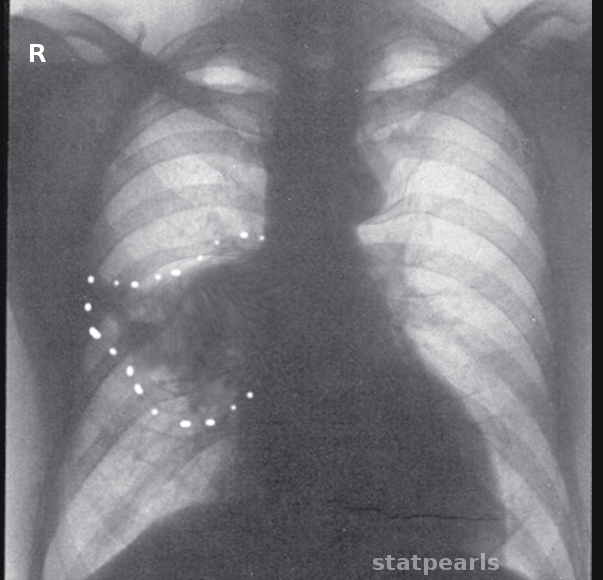[2]
Gudbjartsson T, Gudmundsson G. Middle lobe syndrome: a review of clinicopathological features, diagnosis and treatment. Respiration; international review of thoracic diseases. 2012:84(1):80-6. doi: 10.1159/000336238. Epub 2012 Mar 1
[PubMed PMID: 22377566]
[3]
Wagner RB, Johnston MR. Middle lobe syndrome. The Annals of thoracic surgery. 1983 Jun:35(6):679-86
[PubMed PMID: 6344820]
[4]
Bertelsen S, Struve-Christensen E, Aasted A, Sparup J. Isolated middle lobe atelectasis: aetiology, pathogenesis, and treatment of the so-called middle lobe syndrome. Thorax. 1980 Jun:35(6):449-52
[PubMed PMID: 7434301]
[5]
Bradham RR, Sealy WC, Young WG Jr. Chronic middle lobe infection. Factors responsible for its development. The Annals of thoracic surgery. 1966 Jul:2(4):612-6
[PubMed PMID: 5934077]
[6]
Kim HC, Kim HS, Lee SJ, Jeong YY, Jeon KN, Lee JD, Hwang YS. Endobronchial tuberculosis presenting as right middle lobe syndrome: clinical characteristics and bronchoscopic findings in 22 cases. Yonsei medical journal. 2008 Aug 30:49(4):615-9. doi: 10.3349/ymj.2008.49.4.615. Epub
[PubMed PMID: 18729304]
Level 3 (low-level) evidence
[7]
Kinzy JD, Powers WP, Baddour LM. Case report: Blastomyces dermatitidis as a cause of middle lobe syndrome. The American journal of the medical sciences. 1996 Oct:312(4):191-3
[PubMed PMID: 8853069]
Level 3 (low-level) evidence
[8]
Lambert GW, Baddour LM. Right middle lobe syndrome caused by Mycobacterium fortuitum in a patient with human immunodeficiency virus infection. Southern medical journal. 1992 Jul:85(7):767-9
[PubMed PMID: 1631699]
[9]
Kwon KY, Myers JL, Swensen SJ, Colby TV. Middle lobe syndrome: a clinicopathological study of 21 patients. Human pathology. 1995 Mar:26(3):302-7
[PubMed PMID: 7890282]
[10]
Rua J, Marques R, Silva R, Gomes B, Fortuna J. Non-Obstructive Middle Lobe Syndrome: An Unusual Cause of Recurrent Pneumonia in an Elderly Woman. European journal of case reports in internal medicine. 2018:5(1):000737. doi: 10.12890/2017_000737. Epub 2018 Jan 31
[PubMed PMID: 30755973]
Level 3 (low-level) evidence
[11]
Einarsson JT, Einarsson JG, Isaksson H, Gudbjartsson T, Gudmundsson G. Middle lobe syndrome: a nationwide study on clinicopathological features and surgical treatment. The clinical respiratory journal. 2009 Apr:3(2):77-81. doi: 10.1111/j.1752-699X.2008.00109.x. Epub
[PubMed PMID: 20298381]
[12]
Mi W, Zhang C, Wang H, Cao J, Li C, Yang L, Guo F, Wang X, Yang T. Measurement and analysis of the tracheobronchial tree in Chinese population using computed tomography. PloS one. 2015:10(4):e0123177. doi: 10.1371/journal.pone.0123177. Epub 2015 Apr 20
[PubMed PMID: 25894917]
[14]
Illamperuma C, Reid J, Kanthan R. Chyloptysis with right middle lobe syndrome complicated postoperatively by chylothorax: an unusual cause of right middle lobe syndrome. Canadian respiratory journal. 2009 Mar-Apr:16(2):e1-2
[PubMed PMID: 19399303]
[15]
Priftis KN, Mermiri D, Papadopoulou A, Anthracopoulos MB, Vaos G, Nicolaidou P. The role of timely intervention in middle lobe syndrome in children. Chest. 2005 Oct:128(4):2504-10
[PubMed PMID: 16236916]
[16]
Paşaoğlu I, Doğan R, Demircin M, Hatipoğlu A, Bozer AY. Bronchoscopic removal of foreign bodies in children: retrospective analysis of 822 cases. The Thoracic and cardiovascular surgeon. 1991 Apr:39(2):95-8
[PubMed PMID: 1877059]
Level 2 (mid-level) evidence
[17]
Wohlauer MV, Moore EE, Haenel JB, Burlew CC, Barnett CC Jr. Selective Intrabronchial Air Insufflation for Acute Lobar Collapse in the Surgical Intensive Care Unit. Journal of surgical radiology. 2011 Apr 1:2(2):178-180
[PubMed PMID: 21687834]
[18]
Livingston GL, Holinger LD, Luck SR. Right middle lobe syndrome in children. International journal of pediatric otorhinolaryngology. 1987 Jun:13(1):11-23
[PubMed PMID: 3623806]

